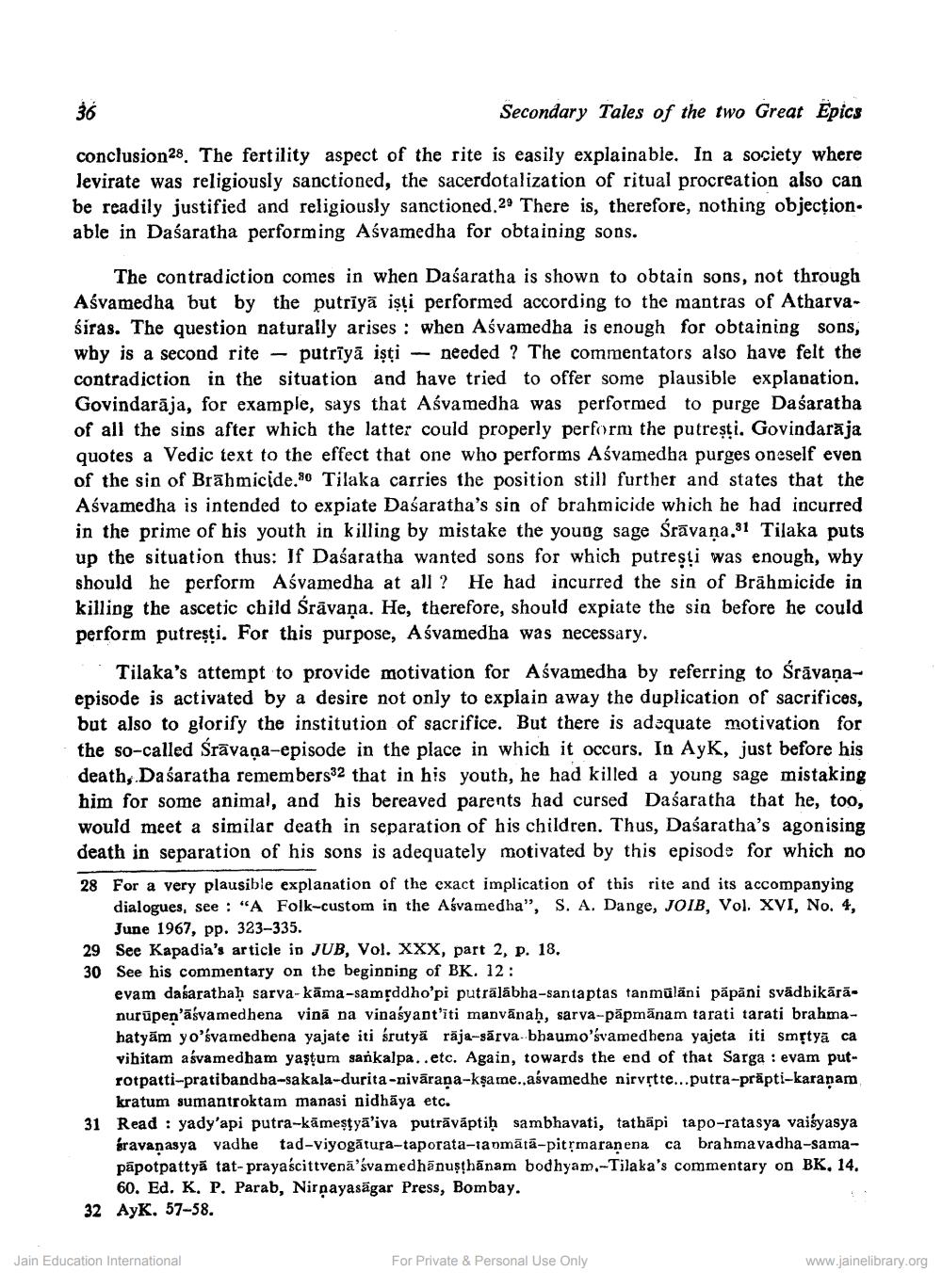________________
36
Secondary Tales of the two Great Epics conclusion28. The fertility aspect of the rite is easily explainable. In a society where levirate was religiously sanctioned, the sacerdotalization of ritual procreation also can be readily justified and religiously sanctioned.29 There is, therefore, nothing objection. able in Dasaratha performing Aśvamedha for obtaining sons.
The contradiction comes in when Daśaratha is shown to obtain sons, not through Aśvamedha but by the putrīyā işti performed according to the mantras of Atharvaśiras. The question naturally arises : when Aśvamedha is enough for obtaining sons, why is a second rite – putrīyā işti – needed ? The commentators also have felt the contradiction in the situation and have tried to offer some plausible explanation. Govindarāja, for example, says that Aśvamedha was performed to purge Daśaratha of all the sins after which the latter could properly perform the putrești. Govindarāja quotes a Vedic text to the effect that one who performs Aśvamedba purges oneself even of the sin of Brāhmicide.80 Tilaka carries the position still further and states that the Aśvamedha is intended to expiate Dasaratha's sin of brahmicide which he had incurred in the prime of his youth in killing by mistake the young sage Śrāvaņa,31 Tilaka puts up the situation thus: If Dasaratha wanted sons for which putrești was enough, why should he perform Aśvamedha at all? He had incurred the sin of Brāhmicide in killing the ascetic child Śrāvaņa. He, therefore, should expiate the sin before he could perform putrești. For this purpose, Aśvamedha was necessary.
Tilaka's attempt to provide motivation for Aśvamedha by referring to Śrāvaņaepisode is activated by a desire not only to explain away the duplication of sacrifices, but also to glorify the institution of sacrifice. But there is adequate motivation for the so-called Śrāvana-episode in the place in which it occurs. In AyK, just before his death, Daśaratha remembers32 that in his youth, he had killed a young sage mistaking him for some animal, and his bereaved parents had cursed Daśaratha that he, too, would meet a similar death in separation of his children. Thus, Dasaratha's agonising death in separation of his sons is adequately motivated by this episode for which no 28 For a very plausible explanation of the exact implication of this rite and its accompanying
dialogues, see : "A Folk-custom in the Aśvamedha", S. A. Dange, JOIB, Vol. XVI, No. 4,
June 1967, pp. 323-335. 29 See Kapadia's article in JUB, Vol. XXX, part 2, p. 18. 30 See his commentary on the beginning of BK. 12:
evam daśarathaḥ sarva-kāma-samddho'pi putrālābha-santaptas tanmūlāni pāpāni svādbikārās nurūpen'āśvamedhena vina na vinaśyant'īti manvānah, sarva-pāpmānam tarati tarati brahmahatyām yo'śvamedhena yajate iti śrutyā rāja-sarva-bhaumo'svamedhena yajeta iti smộtyā ca vihitam aśvamedham yaştum sankalpa..etc. Again, towards the end of that Sarga : evam putrotpatti-pratibandha-sakala-durita-nivāraña-kşame..aśvamedhe nirvștte...putra-prāpti-karanam kratum sumantroktam manasi nidhāya etc. Read : yady'api putra-kāmestyā'iva putrāvāptiḥ sambhavati, tathāpi tapo-ratasya vaisyasya Sravanasya vadhe tad-viyogātura-taporata-raomātā-pitmaranena ca brahmavadha-samapāpotpattyā tat-prayascittvena'svamedhānuşthānam bodhyam.-Tilaka's commentary on BK, 14.
60. Ed. K. P. Parab, Nirpayasāgar Press, Bombay. 32 AyK, 57-58.
Jain Education International
For Private & Personal Use Only
www.jainelibrary.org




